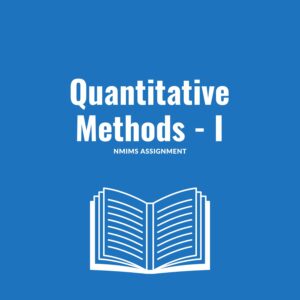Description
Business Analytics
NMIMS Internal Assignment
Jun 2025 Examination
Question 1 Given a dataset with missing values, apply appropriate data treatment techniques to handle the missing data. Justify your choice of method based on the nature of the dataset. Additionally, analyze a real-world scenario where missing data impacts decision-making, and implement suitable imputation methods to improve data quality
| Student_I D | Name | Age | Gender | Math_Scor e | English_Scor e | Attendance (%) |
| 101 | Aarav | 20 | F | 85 | 88 | 95 |
| 102 | Bhavya | 21 | M | 78 | 88 | |
| 103 | Charan | 22 | M | 82 | 92 | |
| 104 | Deepak | M | 92 | 91 | ||
| 105 | Esha | 20 | F | 88 | 85 | 97 |
| 106 | Farhan | 21 | 76 | 79 | 85 | |
| 107 | Gauri | F | 80 | 86 | 90 | |
| 108 | Harshita | 22 | F | 90 | 93 | |
| 109 | Ishan | 23 | M | 90 | 89 | |
| 110 | Jyoti | 20 | F | 84 | 87 |
(10 Marks)
Question 2 (A) A pharmaceutical company is testing a new drug for reducing blood pressure. They conduct a clinical trial with two groups: one receiving the drug and the other receiving a placebo. The blood pressure levels are recorded before and after the trial.
-
- Analyse the components of a two-sample hypothesis test and determine why it
is appropriate or not for this study. (1 Mark)
-
- Given that the obtained p-value is 0.08, break down the decision-making process for rejecting or failing to reject the null hypothesis at a 5% significance level. (1 Mark)
- Examine the potential risks associated with Type I and Type II errors in this study and discuss how they could affect the interpretation of results. (1 Mark)
- The company wants to check whether the drug’s effectiveness varies across different age groups (e.g., 30-40, 41-50, 51-60). Analyse whether the Chi-
square test of independence is an appropriate test in this scenario. (1 Mark)
-
- Differentiate between the Chi-square Goodness of Fit test and the Chi-square test of independence, and analyse how each applies to different types of pharmaceutical studies. (1 Mark)
(5 Marks)
Question 2 (B) A company wants to predict sales based on advertising expenses using a simple linear regression model. The dataset for 5 months is given below:
| Month | Advertising Expense (X in Rs 1000s) | Actual Sales (Y in Rs 1000s) | Predicted Sales ( in Rs 1000s) |
| 1 | 2 | 4 | 3.8 |
| 2 | 3 | 5 | 5.2 |
| 3 | 5 | 7 | 6.9 |
| 4 | 7 | 10 | 9.5 |
| 5 | 9 | 12 | 11.7 |
- Formulate the simple linear regression equation based on the given data.
- Determine the regression coefficients (: Intercept, : Slope) and interpret their impact on sales.
- Derive insights from the regression equation, understanding the baseline performance and the impact of advertising expenses on sales.
- Suggest recommendations based on findings, highlighting the effectiveness of advertising expenses.
Instructions:
- Use Excel to compute the regression equation, coefficients, and R² value.
- Paste the Excel output with formulas to demonstrate calculations.
- Insights should be based on data from Excel analysis
(5 Marks)
Assignment Marks: 20






